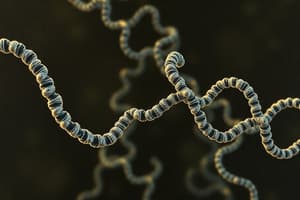Podcast
Questions and Answers
During DNA replication, what is the role of histone proteins?
During DNA replication, what is the role of histone proteins?
- Facilitate the movement of mRNA to the cytoplasm
- Serve as templates for the synthesis of new DNA strands
- Act as enzymes for breaking hydrogen bonds between base pairs
- Help compact DNA and facilitate its association with other proteins (correct)
Which type of chromatin is more accessible for transcription, allowing genes to be expressed?
Which type of chromatin is more accessible for transcription, allowing genes to be expressed?
- Telomeres
- Centromeres
- Heterochromatin
- Euchromatin (correct)
What is the main function of DNA helicase during DNA replication?
What is the main function of DNA helicase during DNA replication?
- Join Okazaki fragments on the lagging strand
- Synthesize new DNA strands
- Unwind the double helix by breaking hydrogen bonds between base pairs (correct)
- Assist in proofreading newly synthesized DNA strands
Which of the following base pairs is correctly matched?
Which of the following base pairs is correctly matched?
Where does the process of DNA transcription primarily occur?
Where does the process of DNA transcription primarily occur?
Which nucleotides are present in a DNA double helix structure?
Which nucleotides are present in a DNA double helix structure?
What is the main difference between DNA and RNA structures?
What is the main difference between DNA and RNA structures?
Which type of nucleic acid plays a crucial role in protein synthesis?
Which type of nucleic acid plays a crucial role in protein synthesis?
What is the function of chromosomes in the cell?
What is the function of chromosomes in the cell?
How many pairs of chromosomes do humans have?
How many pairs of chromosomes do humans have?
Flashcards are hidden until you start studying
Study Notes
Nucleic Acids, Chromosomes, and Chromatin: Unraveling Life's Blueprint
At the heart of living organisms, where heredity and genetic information are encoded, lie nucleic acids. The two types of nucleic acids—DNA (deoxyribonucleic acid) and RNA (ribonucleic acid)—are essential for life, and they are the focus of this exploration, alongside the structures they form within cells to store and transmit genetic information: chromosomes and chromatin.
Nucleic Acids: DNA and RNA
DNA is the molecule that carries the genetic instructions used to build and maintain an organism. Its double helix structure is composed of two long strands wound around each other, with each strand consisting of four types of nucleotides: adenine (A), guanine (G), cytosine (C), and thymine (T).
RNA is a single-stranded nucleic acid that can be messenger RNA (mRNA), transfer RNA (tRNA), or ribosomal RNA (rRNA). It plays a crucial role in protein synthesis and other biological processes, such as DNA replication and regulation.
Chromosomes
Chromosomes are structures composed of DNA and proteins located in the nucleus of cells. Each chromosome is a single, double-stranded DNA molecule with associated proteins that help compact the DNA and stabilize its structure. Chromosomes are visible during cell division, and they are essential for the transmission of genetic information from one generation to the next.
In humans, we have 23 pairs of chromosomes. Each pair has one maternal chromosome and one paternal chromosome, except for sex chromosomes, where females have two X chromosomes, and males have one X and one Y chromosome.
Chromatin
Chromatin is the complex of DNA and histone proteins that make up the chromosomes during interphase, or when the cell is not dividing. Chromatin is found in the cell nucleus, and it exists in two main forms:
- Euchromatin: Loosely packed chromatin that is more accessible for transcription, allowing genes to be expressed.
- Heterochromatin: Highly packed chromatin that is less accessible for transcription and generally found in regions that do not contain actively expressed genes.
Histone proteins are critical components of chromatin. They help compact DNA and facilitate the association of DNA with other proteins, such as transcription factors and histone-modifying enzymes.
DNA Structure and Replication
The double helix structure of DNA allows it to be copied during cell division. This replication process involves separating the double helix into two single strands, which then serve as templates for the synthesis of new DNA strands. Each strand is complementary to its partner, with A always pairing with T, and C with G. This information is crucial for the fidelity of DNA replication.
DNA Transcription and Gene Expression
DNA is transcribed into RNA in a process called transcription. This process takes place in the nucleus and involves the formation of an RNA molecule whose sequence is complementary to the DNA template strand. The mRNA then moves to the cytoplasm, where it serves as a template for the synthesis of proteins.
Understanding nucleic acids, chromosomes, and chromatin is essential for grasping the fundamental processes that make life possible. From DNA replication and transcription to gene expression and protein synthesis, these structures and processes are at the heart of biology, shaping the evolution and function of living organisms.
Studying That Suits You
Use AI to generate personalized quizzes and flashcards to suit your learning preferences.




